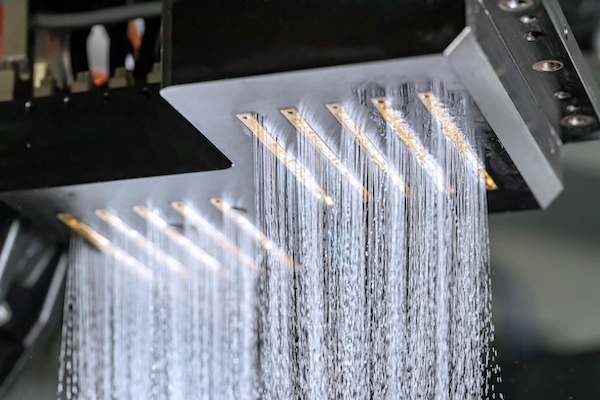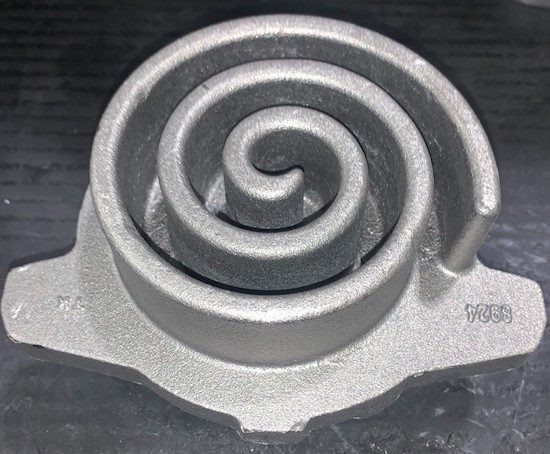AM Gets Sustainability Stamp of Approval
New research shows the production method is gaining momentum for helping enterprises meet their broader sustainability goals.

Desktop Metal’s binder jet 3D printer was the production engine for the AMGTA LCA conducted on the Trane part. Image courtesy of Desktop Metal.
Latest News
November 30, 2023
Sustainability is emerging as a lever to boost adoption of additive manufacturing (AM) technologies, confirmed by new research that highlights the production method’s ability to move the needle on key Environmental, Social and Corporate Governance (ESG) goals.
The Additive Manufacturer Green Trade Association (AMGTA), a global advocacy group tasked with promoting sustainable AM industry practices, recently announced preliminary results of its latest lifecycle analysis study that confirmed various sustainability benefits associated with AM. The group’s lifecycle assessment reports (LCAs) are peer-reviewed research studies designed to explore the cradle-to-grave environmental impacts of specific products manufactured with AM and compared with the same product built with more traditional production methods.
The most recent LCA study (“Comparative Lifecycle Assessment: Comparison of Casting vs. Binder Jetting for an Industrial Part”) was commissioned by AMGTA and conducted by the Yale School of the Environment (YSE) in partnership with Desktop Metal and Trane Technologies, a global HVAC manufacturer. In 2021, AMGTA established the Sustainability of Additive Manufacturing Research Fund, a $100,000 program designed to support LCA research at the Yale facility.
With this latest LCA study, the partners used a steel scroll chiller that is part of Trane’s HVAC systems to explore the manufacturing and environmental impact of binder jet 3D printing, performed on a Desktop Metal printer, compared to traditional metal casting. The preliminary results confirmed a 38% reduction in greenhouse gas (GHG) emissions related to use of the binder jetting process—a benchmark primarily driven by reduced energy demand during the production phase.

An AMGTA LCA study revealed a 38% reduction in CO2 emissions through AM production of a steel scroll chiller part used in a Trane HVAC system. Image courtesy of Trane.
There were some notable standouts in the findings, according to Sherri Monroe, AMGTA’s executive director. The 38% drop in CO2 emissions was higher than anticipated when the partners set out on the project, Monroe says.
In addition, while the study showed the environmental impacts of producing source powder for the AM binder jetting process were approximately twice that compared to casting steel, the overall increase ended up representing only a small portion of the overall GHG emissions. In that way, it did not play a significant role in the findings, she says.
“You end up paying a little upfront [in terms of GHG emissions] to achieve big savings throughout the rest of the process—that’s important to understand,” Monroe says.
One of AM’s key attributes—the ability to produce lightweight, organic-shape part designs—turned out to have negligible value in this particular use case, Monroe says.
The potential benefits of redesigning the Trane scroll chiller part to a more lightweight interpretation using lattice-type structures were insignificant with respect to reducing GHG emissions. Instead, it was the overall dimensions of the part being produced and the efficient use of print volumes that played a more significant role in achieving the CO2 reduction objectives.
One lesson resulting from this LCA study was learning that the efficiency of the printer setup and usage had a more significant impact than the lightweighting tactics, Monroe continues.
“The printer is still running for the same amount of time and using the same energy regardless of one part or five parts,” she says. “The key is to match the printer to the job—a bigger printer makes sense if you’re putting out a lot of parts at once while an on-demand job, where one part is produced at a time, requires something else,” she says. “Understanding the use case, employing the right technology, and within that technology, using the right printer, that’s the key.”
For its part, the study should put Trane in a better position to move forward with AM, according to Kevin Klug, lead additive manufacturing engineer for Trane Technologies.
“Prior to this project, uncertainty about the lifecycle emissions of binder jetting versus conventional manufacturing approaches was a barrier to AM adoption,” he says.
Now, Trane is afforded more insight to consider AM’s cost, productivity and environmental impact earlier in the product’s design cycle when risk is low and potential benefits high, he adds.
Lightweighting Benefits Shine
Monroe says the findings of this LCA study and other research should help companies looking for more environmentally friendly production methods embrace AM as part of broader sustainability initiatives.
This LCA study, done with Trane, Yale and Desktop Metal, follows an earlier study involving the Golisano Institute for Sustainability (GIS) at Rochester Institute of Technology. That study, titled “Comparative LCA of a Low-Pressure Turbine (LPT) Bracket by Two Manufacturing Methods,” analyzed an AM-designed and manufactured aerospace component compared to the same part produced with traditional methods.
Specifically, the two-year RIT study looks at the cradle-to-grave environmental impacts of a jet engine low pressure turbine (LPT) bracket produced through traditional manufacturing methods compared to one produced with laser powder bed fusion (LPBF). The study committed to evaluating up to 18 different environmental indicators to quantify the environmental impacts that an optimized jet engine LPT bracket has throughout the entire lifecycle, from material extraction, manufacturing, transportation, use and eventual end of life.
In this case, the application achieved a greater than 50% weight reduction of the bracket over the life of the aircraft, which helped reduce the carbon impact. Yet the results were inconclusive regarding which manufacturing method was more energy efficient.
As part of its ongoing research and LCA studies, AMGTA plans to look beyond production and explore distribution and other factors. Monroe says it’s important to not only compare AM with traditional production capabilities, but to also consider the totality of capabilities AM brings.
“Our goal is to expand the thinking around AM and look at the bigger business case in different industries and applications,” she explains. “It’s like comparing an iPhone to a landline—if you just consider the quality of the phone call, you’re missing what a smart phone brings to the table.”
Essentium, another player in the 3D printer market, also released research findings that showcase the big-picture benefits of AM and corroborate its impact on sustainability. The research shows that nearly all manufacturing respondents (94%) are actively engaged in initiatives to reduce carbon emissions with more than half (53%) reporting mature and strategic programs in place. Moreover, of those with sustainability initiatives, 86% have experienced a positive impact, including less waste (40%), shorter supply chains (36%), fewer or no overruns (33%), reduced footprints for parts transportation (31%), and lowered carbon footprint (30%). Additional upsides: Less heavy logistic requirements (28%) and smaller storage footprints (27%).
Blake Teipel, CEO of Essentium, says the positive momentum outlined in these studies doesn’t even take account the full benefits of AM for accelerating time to part, either by preventing long lead times waiting on suppliers and enabling local production or eliminating overproduction of parts that leads to unused inventory taking up shelf space.
“There are many areas AM touches across the total lifecycle of parts that can bring benefits,” Teipel says. “AM should be deployed for any organization trying to reach its carbon goals.”
Beth Stackpole is a contributing editor to DE. You can reach her at [email protected].
Subscribe to our FREE magazine, FREE email newsletters or both!
Latest News
About the Author
Beth Stackpole is a contributing editor to Digital Engineering. Send e-mail about this article to [email protected].
Follow DE





